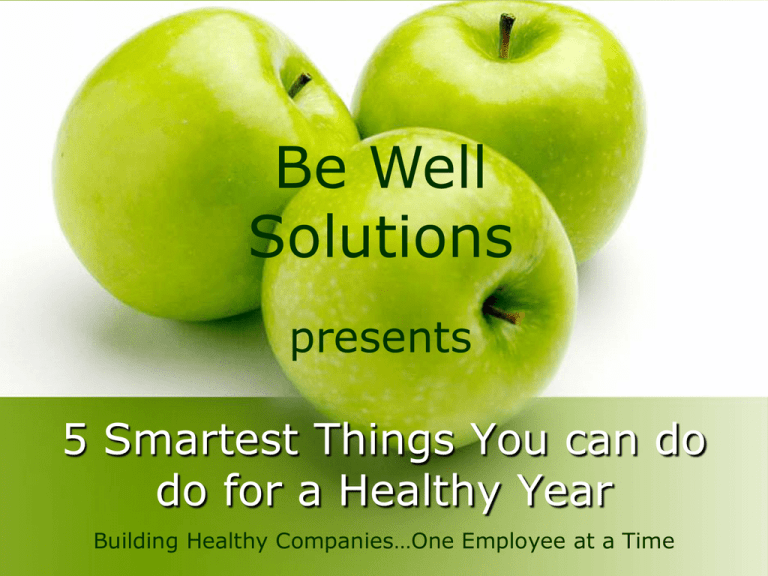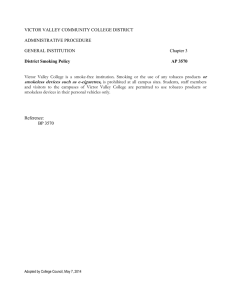Be Well Solutions 5 Smartest Things You can do
advertisement

Be Well Solutions presents 5 Smartest Things You can do do for a Healthy Year Building Healthy Companies…One Employee at a Time Your Wellness Program Partners Angela J. DeJulius, M.D., MPH Director, Kent State University Health Services DeWeese Health Center 1500 Eastway Drive Kent, OH 44242 330-672-2322 Kent State Departments Health Promotion Recreational Services Nutrition and Dietetics Human Resources Be Well Solutions Physician owned and operated. Staffed by professionals experienced in patient care, behavioral change and education and concerned about helping you. Fully HIPAA compliant Mission: bring prevention through wellness services to business with face-to-face helping relationships. More Information Through Be Well Solutions www.bewelldata.com Speak to a Health Coach, Registered Dietitian or Diabetic Nurse Educator Contact any of our Health Professionals for follow up information Five Smartest Things You Can Do Let’s Start Simple Today’s Lecture is brought to you by the letter E and the number 5 5 Smartest Things 1. 2. 3. 4. 5. Evaluation – Know Where You Stand Exercise Properly – How and How Much Eating Smart – Basic Strategies Emotional Balance and Proper Sleep Eliminate or Avoid Tobacco/Nicotine Products Number 1-Evaluate Your Current Status Quantify and Record Your Present Health Status Why take a look.. There are a number of conditions that proceed silently for years High Cholesterol High Blood Pressure Elevated Blood Sugar Osteoporosis Glaucoma Weight issues Your Vital Statistics Inventory of Lifestyle and Situation Nutrition and Weight Smoking/Tobacco Family History Health Measurements, Prevention and Screening Fitness Current Medical Condition Preventative Measures Immunizations Disease Screening Tests Cancer Screens Glaucoma Screens Dental What to do with the info Review your results with your doctor • Understand conditions you didn’t know about previously. • Identify “red flags”. • Establish a starting point for healthy changes. • Set meaningful goals • Develop a Personal Action Plan Cornerstone of The Affordable Care Act Annual Preventive Care Exams Tips for Understanding Your Health Status Know your numbers Learn about proper screening exams Body Mass Index Blood Pressure Blood Sugar Cholesterol Cancer Glaucoma Dental Checkup Immunizations Be an Informed Health Consumer Become an Informed Health Care Consumer Pick your doctor Plan doctor visits wisely Decide what you want to accomplish Ask questions with confidence Take part in decisions Ask for a summary Ask for resources Take charge of your medical records and health care decisions Tips to Help Become an Informed Consumer www.bewelldata.com Number 2 Exercise Every Day Exercise is a Necessity About 170 million Americans don’t get enough healthy physical activity on a daily basis. Make exercise a priority…. Why You Should… Exercise counts the most toward good health Living longer and better Protects you from dozens of serious illnesses Heart Disease/High Blood Pressure Type II Diabetes Stroke Certain Cancers Osteoporosis Falls Depression and Anxiety Impotence Alzheimer’s Disease On The Other Hand…. Not being active damages your heart and other major organs— cutting your life short. Fat accumulates Makes it harder to lose weight Bones shrink and get weak Our ability to recover from injuries diminishes Exercise Say “Yes” to: Strength Training 2-3 Times per Week Aerobic Exercise every day 30 minutes total at 80% of maximum heart rate (maximum heart rate is equal to 220 less your age) Breaking up exercise into short bursts of activity throughout the day strengthens the heart just as well as one long workout. Flexibility Training Variety in your exercise program F.I.T.ness Remember F-I-T F-frequency (how often) I-intensity (how hard) T-time (how long) Tips for Beginning Exercise Caution: If you’re out of shape or have certain health conditions, talk to your doctor about how (not if) to begin. Keep it Simple – what works for YOU? Join a gym Take a class Get a partner Get a pedometer Get a dog Develop an action plan More Tips For Exercise www.bewelldata.com Number 3 Eat Smart Food in America Today Fast lifestyles demand fast food The perception of value depends on portion size Spending on fast food has increased exponentially in recent years. The fast food industry is growing at an alarming rate. Why You Should… Poor nutritional habits increase risk for Adult onset Diabetes Cancer Heart disease Stroke Alzheimer’s Disease Obesity and being overweight cause 300,000 premature deaths annually. Pile on the Fruits and Vegetables Vegetables Vary Colors Concentrate on vegetables grown above the ground and Fruits Berries Apples Wash thoroughly Avoid Bad Carbohydrates Stay away from Sugars and Refined Grains: Sugar Corn syrup Cornstarch High-fructose corn syrup Fruit Juice Concentrate Maltose Dextrose Honey Maple Syrup Brown Sugar Refined Grains White White White White Bread Rice Pasta Cereals Look for Healthy Sources of Protein Healthy Sources: Beans, Legumes Raw seeds Raw nuts Organic Eggs Cold and deep water fish Lean animal meats Unhealthy Sources: Protein from processed, cured, smoked or dried meats Protein from scavengers such as pork, shellfish, shrimp, lobster, crab and clams. Protein from meat and dairy products including milk and cheese. Understand Fat as a Part of Your Diet Healthy Fats Cold Water Fish Flax seed, raw sunflower and pumpkin seeds Eggs – organic Plant based butter substitutes and real butter in moderation Saturated fat from Lean/Organic Animal Products Avoid Trans Fats = “Hydrogenated or Partially Hydrogenated Oils” Saturated fats from many animal sources Powdered Coffee Creamers Nutrition Strategies Tips for Eating Right: Understand calories Read food labels and ingredient lists Cook at home Eat slowly and stop when 70% full Walk after eating Make good choices at restaurants and work most of the time Fiber Is Essential… Eat whole fruits instead of drinking fruit juices. Replace white rice, bread, and pasta with brown rice and whole-grain products. Choose whole-grain cereals for breakfast. Snack on raw vegetables instead of chips, crackers, or chocolate bars. Substitute legumes for meat two to three times per week in chili and soups. Experiment with international dishes that use whole grains and legumes as part of the main meal or in salads. From EAT, DRINK, AND BE HEALTHY by Walter C. Willett, M.D. Copyright © 2001, 2005 by the President and Fellows of Harvard College. Reprinted by permission of Free Press/Simon & Schuster, Inc Tips For Nutrition www.bewelldata.com Number 4 Emotional Balance Why You Should… Unmanaged stress has been linked to the nation’s two leading causes of death—heart disease and cancer. Heart disease Stress is a potent a trigger of heart disease. Stress puts as much strain on the heart as elevated blood pressure. Cancer Some studies indicate an increased incidence of early death, including cancer death, among people who have experienced major life stress factors. The Benefits of Learning Stress Management Managing stress will help… Improve how your immune system functions. Increase your energy level. Improve your confidence, ability to make decisions and quality of life. Improve the quality of your sleep. Keeps you calm when the going gets tough. Allows you to be on your game—more focused, more positive. Conditions related to excess sympathetic outflow Depression/Anxiety Disorders Suicide High Blood Pressure Migraine headaches Digestive problems Lung ailments Sleep Disorders Back Pain Sympathetic Parasympathetic Symptoms of Unmanaged Stress Headaches Stomach Problems Anger Depression Guilt Hopelessness Overeating Alcohol Abuse Exhaustion Sleeplessness Impatience Smoking Stress Reduction Find Relaxation Techniques that Work for You Meditation Breath work Progressive relaxation Yoga Visualization Exercise Stress Reduction Being Social/Spiritual Time Management Proactive Problem Solving Music Pets Stress Reduction Avoid Drugs and Alcohol Ignoring Problems Unhealthy Coping Mechanisms Chronic Medication without lifestyle changes Your EAP – Employee Assistance Program www.myimpactsolution.com Speak with a qualified professional about a host of issues. 24/7 Confidential Effective Tips For Emotional Balance www.bewelldata.com Number 5 Eliminate Tobacco Products Why You Should Be Concerned Smoking causes death The adverse health effects from cigarette smoking account for an estimated 443,000 deaths, or nearly one of every five deaths, each year in the United States.2,3 More deaths are caused each year by tobacco use than by all deaths from human immunodeficiency virus (HIV), illegal drug use, alcohol use, motor vehicle injuries, suicides, and murders combined.2,4 Smoking makes you and those around you sick Heart disease increased by 2 to 4 times,1,5 Stroke increased by 2 to 4 times,1,6 lung cancer increased by 13-23 times, Lung Diseases (such as chronic bronchitis and emphysema) by 12 to 13 times.1 Smokeless is Not Safe Smokeless Tobacco Causes Cancer Esophageal cancer Oral cancers including cancers of your mouth, throat, cheek, gums, lips and tongue Pancreatic cancer Renal (kidney) cancer Smokeless Tobacco Causes Heart Disease Smokeless Tobacco is Addictive E-Cigarettes Stay Away – Addictive and Dangerous Quitting is Possible Nicotine addiction is one of the most difficult to overcome…but it is possible. Quitting Smoking The Results Quitting Resources Quitlines Be Well Solutions Telephonic Smoking Cessation 1-888-WEL-SERV Impact Employee Assistance Final Review – The 5 E’s 1. Evaluate Your Current Health Status 2. Exercise Every Day 3. Eat Right Most of the Time 4. Emotional Balance 5. Eliminate Nicotine and Tobacco Questions/Comments

